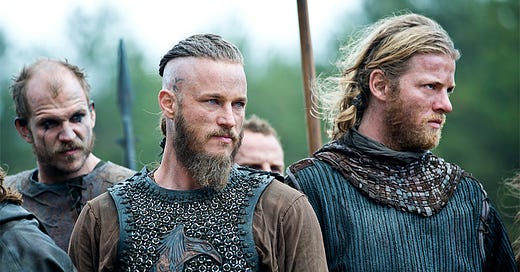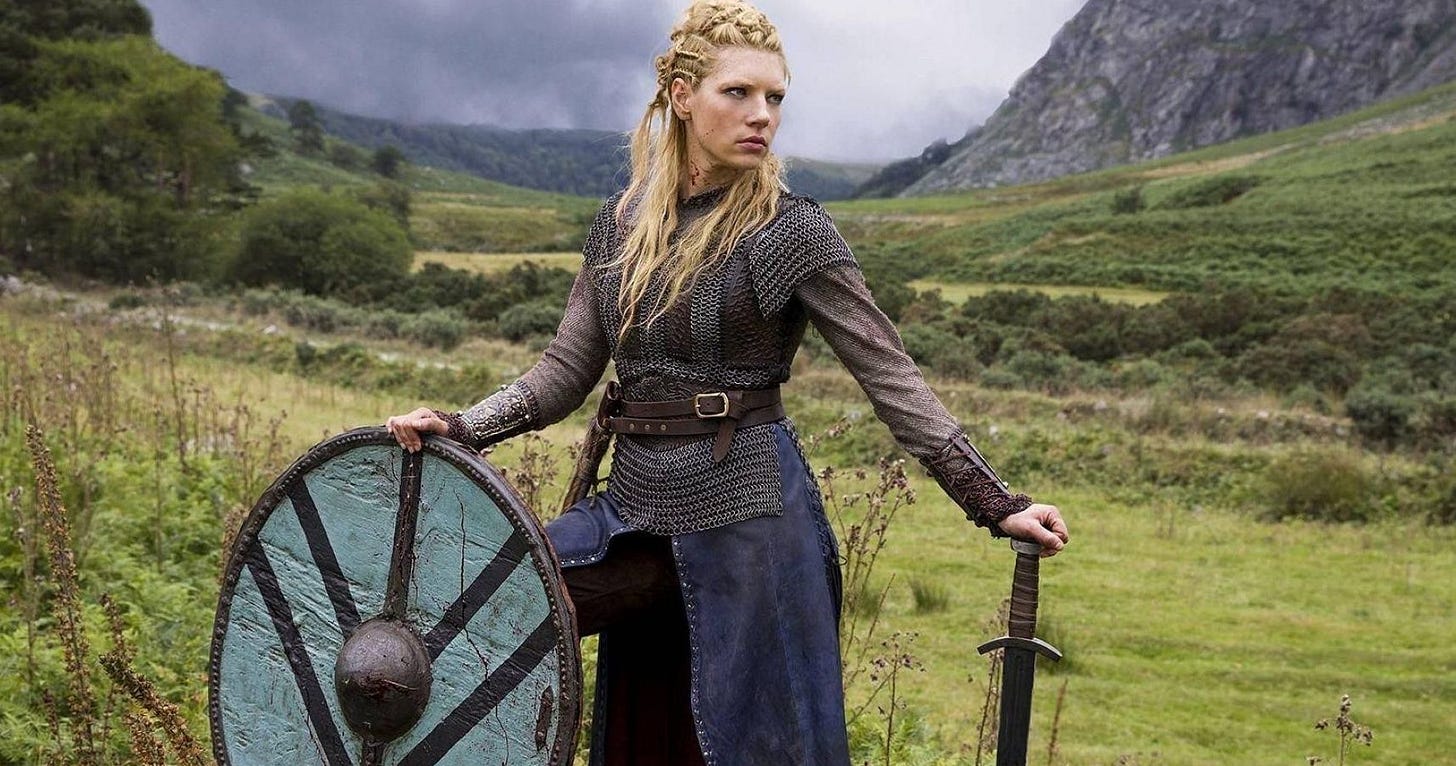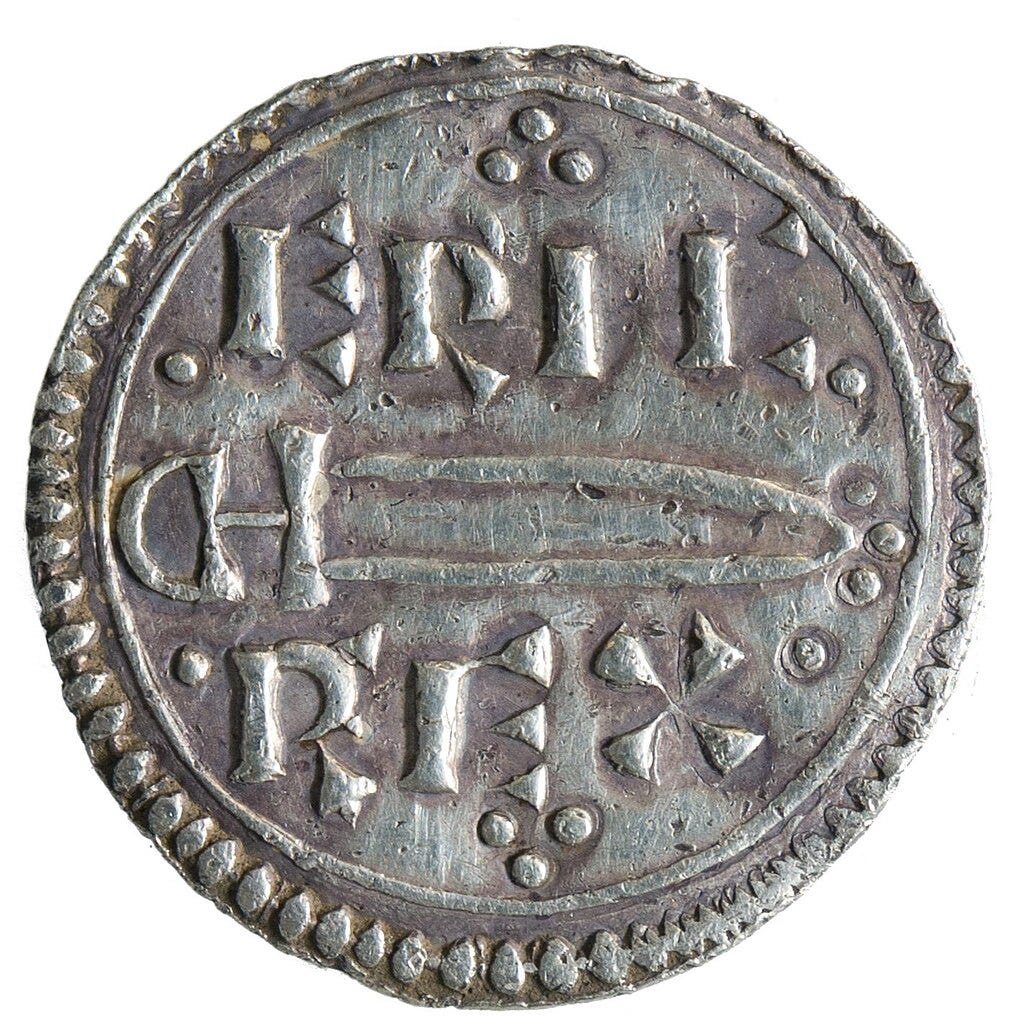Bloodaxe, Vikings and the real history behind a historical drama mega hit
With news of a new Vikings-era drama, Bloodaxe, on the horizon, Rebecca Rideal speaks to Vikings producer, scriptwriter and historical advisor, Justin Pollard.
Over a decade after everyone else, I finally started watching Vikings (Netflix) and what a feast it is! Battles, love affairs, high stakes adventures and amazing costumes. Its rich in historical detail and full of story. But the Viking era is hundreds of years before my period of interest, so I want to know more - How did they really dress? What did Northumbrians make of early Scandinavian raiders? What other Viking stories are ripe for TV?
With news of a brand new Viking-era series coming to Amazon Prime, which will follow the real historical figures Erik Bloodaxe and Gunnhild, who better to ask than Vikings historical advisor and scriptwriter, Justin Pollard? The author of many acclaimed works of nonfiction, including Alfred the Great: The Man Who Made England and World of the Vikings, Pollard has advised on numerous films and TV series and kindly agreed to answer my questions. Enjoy!
From kohl eyes and long beards to braids and partially shaved heads – the Viking ‘look’ is very distinctive. How much of this aesthetic has its roots in historical source material.
It’s a combination. Most importantly the hair and make-up designers have got to create a look that easily identifies each characters, says something about their personality and is practical for filming. But the inspiration is drawn from what historical evidence we have.
Vikings were actually quite fastidious. John of Wallingford, prior of St. Fridswides, complains that the Viking Age men of the Danelaw combed their hair, took a bath on Saturday, and frequently changed their woollen garments. This, he thought, enabled them to seduce English women - something he considers rather unfair.
The Vikings also bathed their hands and faces on at least a daily basis, usually in the morning upon rising. Hávamál suggests that handwashing was customary before meals as well. Only when in mourning was it acceptable to go unwashed.
As for the styles of hair and make-up there was no single style, and personal preference and cultural background might all have had an influence.
Slaves (thralls) had their hair kept short - probably to identify them and to reduce the occurrence of lice. The Arab traveller Ibn Fadlan, in his book ‘Ibn Fadlan and the Land of Darkness’ describes his journeys among the Kievan Rus who, he says, bleached their beards to a saffron yellow, probably using a caustic soap.
What we know of particular hairstyles and makeup comes from a few sources. Firstly there’s the archaeological evidence - particularly amulets and runestones which show hair in men often to shoulder length - and with a full beard as well as various women’s styles. For some warriors we used the Bayeux tapestry which shows the Normans (descended from Vikings themselves) with a hair cut with a shaved back. This was probably done to make the wearing of the typical Norman helmet more comfortable and secure.
What do we know about Viking tattoos?
Tattooing is difficult to recover from the archeological record as skin is very rarely preserved and, as such, we have very little to go on when it comes to talking about Viking practices. Having said that we do have a written record from the Arabic traveller Ibn Fadlan who spent time with the Viking Rus. He says:
“Each man has an axe, a sword, and a knife, and keeps each by him at all times. The swords are broad and grooved, of Frankish sort. Each man is tattooed from finger nails to neck with dark green (or green or blue-black) trees, figures and such like.”
We’re not quite sure what Ibn Fadlan means by ‘trees’ and ‘figures’ but it sounds rather like the intertwining animal motifs of Viking art such as the ‘gripping beasts’ of the Oseberg style. Tattooing would have been carried out using soot and vegetable dyes pricked into the skin with a sharp needle.
Women occupy a varied and interesting space in Vikings – from shield-maidens to oppressed bargaining tools. What was the reality for women during the Viking era?
Women had a role in Viking society very unlike that of women in most of the rest of Europe. This obviously depends on class as slave women, like their male counterparts, have no real rights at all. However what marks out Viking society is that the difference between male and female rights are much less stark.
In Frankia (the territory inhabited and ruled by the people known as Franks, which would later form the core of France) the women were chattels - belonging first to their fathers and then their husbands. Their property and possessions equally belonged in law not to them but the man who had power over them. There were some exceptions amongst the very highest in society but this was the general rule.
In Viking society this wasn’t the case. Father’s would generally select a suitable husband for their daughters but would ask the daughters opinion as well. Marriage was fundamentally considered a practical political institution - helping to bond families together - rather than a love match. Love might follow later. A father who didn’t ask his daughter could still force the marriage through but might find that the daughter later renounced it.
Viking society was still delineated on male/ female lines and women couldn’t vote in the Thing or explicitly hold a lot of political power but women did wield huge influence. It was the husband’s place to travel and trade and hunt but the wife ruled the home. Step over the threshold and you enter her world. On her belt she would carry the keys to every lock in the house, the treasure, the land and all the family had is in her care. Those possessions were hers and, if the marriage ended she could take them all with her.
Although the man was still considered the ‘ruler’ of the household women took a robust role in managing him – often demanding vengeance when insulted by another family or sometimes cooling down situations where hot-headed men might otherwise get into a dangerous feud. A woman expected to be listened to if not obeyed. Whilst there was undoubtedly domestic violence there are few records of husbands hitting their wives and violence against women was generally taboo. There are cases where, having done so, the woman has repaid the blow with a knife in the chest whilst he slept. No-one seemed to think this unreasonable.
If a husband and wife didn’t get on the wife could divorce him, without his permission. All she needed to do was take her witnesses first to the door and then the bedside and declare there that the marriage was over. The husband then had to return her dowry and other gifts and leave. If her husband’s died she could chose another husband or live without, as she wished.
Is Viking a modern term? How would seafaring Scandinavian people during this time have seen themselves? Did they use a collective identifying term?
To a contemporary Scandinavian a vikingr was a pirate. There was also the abstract noun viking, meaning 'the act of going raiding overseas'. So the term should really only be applied to those actually engaged in these pursuits, and not to every contemporary Scandinavian farmer, merchant or craftsman, nor even to warriors fighting in the dynastic wars of their lords or in their own private feuds. However such was the impact of these raids in Europe that we have come to refer to the whole period as the Viking Age even though the term would have meant little to people at the time.
So, what did they call themselves? We’re not entirely sure. Most probably identified with the area they came from - Norsemen (Norðmaðr), Danes etc. or with a particular clan - Svear, Geats etc. There is some later mediaeval evidence that they called themselves Ostmen (East men) but this might have been non-Scandinavian locals name for them.
Was Ragnar Lothbruk a real person?
Ragnar Lothbrok is the first real Viking personality to emerge from the hazy accounts of this period. Even so, he belongs as much to the fable-filled pages of the sagas as to the sober entries in the chronicles of the period. Just who Ragnar was is still a matter of debate, due in part to the eagerness of contemporary writers to kill him off—an event dutifully recorded a number of times, with a number of dates, and accompanied by a number of different reasons.
The meagre chronicles place him variously in England and Frankia. By one account, he dies of dysentery at the siege of Paris; in another, he survives, only to reappear in Scotland and the Western Isles, before arriving in Dublin, Ireland. An Irish tradition has him dying at the hands of rivals on Carlingford Lough; but his saga drives him on to Anglesey and then Northumbria, where he meets his nemesis, King Aelle.
That these early pirates should become folk heroes is less surprising than it might appear. The currency of the emerging Viking leaders was one we still understand today: fame. To command a great army, a Viking leader needed fame—to bring men to his side, to persuade them to follow him to danger and perhaps death, to put fear in the hearts of his enemies and rivals. Reputation made and broke Scandinavian warlords, and tales of their achievements were vital to their success. No doubt these were often greatly exaggerated even at the time, and then further embroidered with each retelling, so by the era of the saga writers such leaders had often become impossibly heroic.
Of all these heroes, the archetype was Ragnar. In fact, many who followed would be called “Sons of Ragnar,” a title that was often as much a mark of honour or aspiration as a statement of genetic fact. To be a Son of Ragnar, and there were many, was to be set apart, to be a terror of the world. So successful was this family that, for generations to come, every great and powerful Norse leader would claim to be descended from the Sons of Ragnar. Their fame may still be seen in a surviving piece of Viking graffiti in the Scottish chamber tomb of Maes Howe on the Orkney Islands, which describes them as “what you would really call men.”
Season 1 of Vikings follows sacking of Lindisfarne and the conflict between Ragnar Lothbruk’s explorer / raiders and Northumbrians. What were early interactions between Vikings and Northumbrians really like?
The early interactions between Northumbrians and Vikings were extremely violent. The Anglo-Saxon Chronicle for 793 states that in that year:
“..dire portents appeared over Northumbria and sorely frightened the people. They consisted of immense whirlwinds and flashes of lightning, and fiery dragons were seen flying in the air.”
These were, in the minds of any God-fearing Christian, a clear omen and this was an age when omens were taken very seriously. God was sending something to scourge His people, to return them to the true Christian path. He was sending the Vikings. The mediaeval chronicler Simeon of Durham concludes his chronicle entry for that year:
“In that same year the pagans from the northern regions came with a naval force to Britain like stinging hornets and spread on all sides like fearful wolves, robbed, tore and slaughtered not only beasts of burden, sheep and oxen, but even priests and deacons, and companies of monks and nuns. And they came to the church of Lindisfarne, laid everything waste with grievous plundering, trampled the holy places with polluted steps, dug up the altars and seized all the treasures of the holy church. They killed some of the brothers, took some away with them in fetters, many they drove out, naked and loaded with insults, some they drowned in the sea……”
The sacking of Lindisfarne was to be only the first of many attacks on monasteries. The response of the Chroniclers, both contemporary and later, gives a vivid insight into the extraordinary effects these raids had on Christians and pagans alike. Simeon of Durham’s account shows graphically the difference in mindset between the two groups who clashed on Holy Island that 8th June. To Simeon and the other Chroniclers – all of whom were in holy orders themselves – the attacks were the worst blasphemy imaginable. For them it is not the loss of treasure that is most galling but the murder of holy men and women, the ransacking of the religious furniture and the desecration that the very presence of pagans brought to the Holy places. But also in Simeon’s description we can glimpse the sense of amazing good fortune that those Vikings must have felt. Here they were in a group of undefended and meaningless (to them) buildings which contained huge amounts of portable wealth defended only by unarmed monks who were easy to kill or perhaps just as easy to enslave and sell back at home for another healthy profit. The only sanction that protected these monks seemed to be the wrath of a God that they didn’t believe in and whom, even if he existed, did not seem interested in protecting his believers.
The following year, 794, the writer of the Anglo-Saxon Chronicle could at least comfort his readers with a small, if Pyrrhic victory. That year the Vikings returned and plundered Northumbria again although this time some seem to have been shipwrecked in bad weather, the survivors being killed by the locals as they swam ashore. But it was only a minor setback.
Is there a Viking-era story that you would still like to see dramatized?
Absolutely - the story of the Viking King of York Erik Bloodaxe and his feud with the Icelander Egil Skalgrimasson. It has a strong historical basis and a wealth of saga stories to embroider it with. It’s also the story of the foundation of the Norwegian, Danish and Swedish states, and the role taken by three Queens - Ragnhild the Mighty, Thyra and Sigrid the Haughty, not to mention Erik’s extraordinary wife Gunhild Mother of Kings, daughter of Gorm the Old.
Bloodaxe does not have a release date yet, but it is being helmed by the same creative team behind Vikings, including Justin Pollard and showrunner Michael Hirst.












Exceptional series of realistic history with all of its modern human nature against the backdrop of the times.
I loved this account!